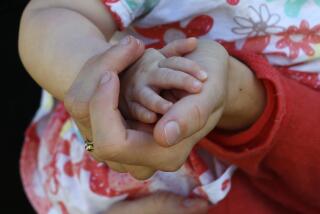Opinion: Stay-at-home moms: The sad truth behind those rosy media stories
The media have become fond in recent years of glamorizing stay-at-home moms as elite career women who have “opted out” of the workforce so they can put family first. Finally, the Pew Research Center has provided the reality check we’ve needed.
“The share of mothers who do not work outside the home rose to 29% in 2012, up from a modern-era low of 23% in 1999,” Pew’s new report finds. The primary reason: economics. The cost of child care and the lack of job opportunities are forcing women to stay at home rather than go back to work after having kids.
Considering these findings, can we please kill the image of the modern stay-at-home mom clad in pricey Lululemon and instead focus on the kinds of precarious economic realities women face?
Affluent stay-at-home moms who’ve chosen to leave the workforce to raise their families often get the media spotlight (see, for examples, the New York Times Magazine’s “The Opt-Out Revolution” and New York Magazine’s “The Retro Wife”), but they make up a small percentage -- 5%, according to Pew -- of women in the U.S. These are not women whose families struggle to make ends meet when both parents are employed. These are parents who have the financial means to “put family first” by being at home.
The problem with the media obsession with the rich stay-at-home mom is that these stories overshadow the fact that most stay-at-home moms are, in fact, poor. Pew found that a startling 34% of stay-at-home moms are living in poverty.
The Pew report also attributes the rising costs of child care to the increase in stay-at-home moms. The Washington Post published a map last week that shows the cost of full-time infant day care in 31 states actually exceeds the cost of state college tuition. At the top of the list is Massachusetts, where the annual cost of having an infant in full-time day care is about $16,000. By contrast, a year at a public college in Massachusetts costs about $10,000. Now imagine the cost of day care if you have more than one child under school age. According to a 2010 Census paper, it is likely that unless she has very high earnings, a mother with more than one child under the age of 5 makes less than it costs to pay for her kids’ day care.
While the numbers are certainly alarming, it is a relief to see the media briefly turn away from the “mommy wars” that focus solely on the decisions of the privileged few to talk about the rest of us trying to raise families. It’s difficult to make the case for policy changes that could make day care more affordable if we never hear about how families are struggling with the costs. I work part time to keep my foot in the professional door. I know that if I step out of the workforce entirely, my potential earnings decrease for every year I am away from work. Each check I receive goes straight to paying for my toddler’s day care bill, and it’s just the way it goes.
I’m not a stay-at-home mom, but I very much identify with the financial conundrum of trying to not only have it all but do it all, with not very much. Until we have policies that can start to reel in the cost of high-quality child care or help low-income moms gain skills to boost their earning potential, we’ll continue to see these numbers rise.
ALSO:
CBS should’ve hired the other ‘Stephen Colbert’ to replace Letterman
Despite its cute graphic, Paycheck Fairness Act was evil spawn of Lilly Ledbetter
Edward Snowden: A whistle-blowing outlaw, now with a Pulitzer Prize to his name
Susan Rohwer is a freelance journalist. Follow her on Twitter @susanrohwer.
More to Read
A cure for the common opinion
Get thought-provoking perspectives with our weekly newsletter.
You may occasionally receive promotional content from the Los Angeles Times.






